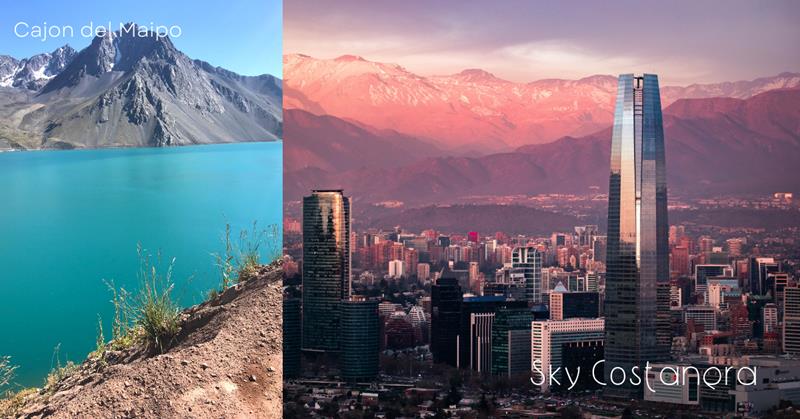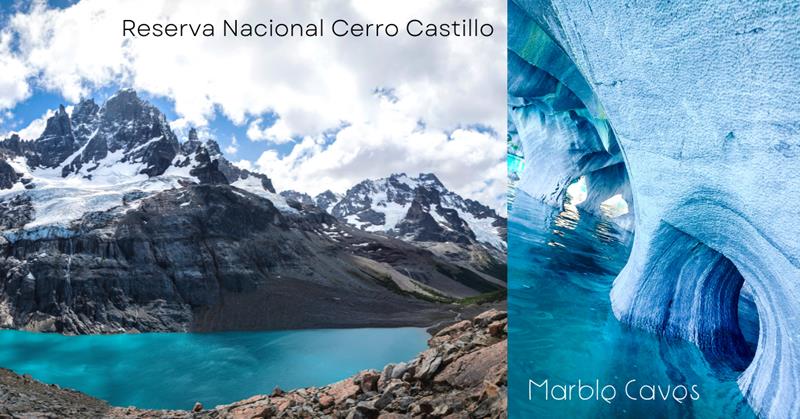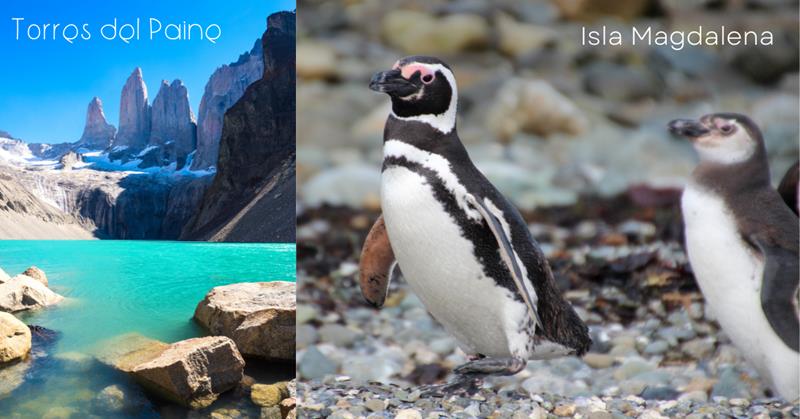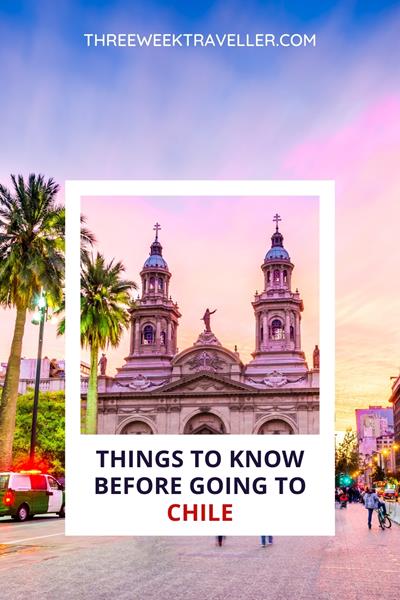Chile is a South American country that is not as well known as other countries in this region, such as Brazil, Colombia, Argentina, etc. It is a relatively small country with a population of only 18 million.
Although Chile is one of the most earthquake-prone countries the government developed some of the best structural engineering and seismic building codes that result in earthquakes having less destructive effects in this country.
Not convinced yet? One of the world’s largest swimming pools could be found in Chile. You could also ski and surf within the same day here if you’re up for a 3-4 hour drive. Chile is the seventh-largest wine producer in the world.
So you see, no matter what your definition of fun or good time is, you can easily find it in Chile. This 3 weeks in Chile itinerary will show how you can spend your vacation well.
BASIC TRAVEL TIPS FOR TRAVELLING TO CHILE


Chile consists of landscapes of contrasts, plains, valleys, waterfalls, and more. You can also experience the festivities firsthand. But before we jump right into the list of places to visit in Chile, there are some things that you need to know, which I will list below.
Getting around
Travelling around Chile is easy and inexpensive compared to Europe or North America. The fastest way is by air, with domestic flights connecting major cities like Santiago, Valparaíso, and Punta Arenas.
For affordability, buses are your best bet, which most locals use. They offer extensive coverage, comfort, and reasonable prices, making them ideal for longer journeys. For shorter distances or exploring cities, consider the metro in Santiago or reliable local taxis and rideshare apps.
You can also opt to rent a car and drive as there is a good road network. Driving around wouldn’t be a problem.
When is the best time to go to Chile
Chile has four seasons: winter, spring, summer, and fall. Remember, the seasons are the other way around since it’s in the southern hemisphere. The winter season starts from June to August, followed by spring, which starts from September to November. Then summer, from December to February, and fall, which starts from March to May.
The best time to visit Chile depends on your interests. For outdoor adventures and trekking in Patagonia, go during the Southern Hemisphere’s summer from December to March.
If you’re keen on skiing or snowboarding, June to September is ideal. The Atacama Desert can be visited year-round. For cultural experiences like local festivals, consider September for the Fiestas Patrias.
The bottom line is that Chile can be visited all year round with various activities in each season. Depending on the season you plan on going, make sure to pack properly.
Language and currency
The official language of Chile is Spanish. While English is not widely spoken outside major tourist areas and larger cities, travellers can generally get by in these areas with English, especially in hotels, popular restaurants, and major attractions.
It’s advisable to learn some basic Spanish phrases for a smoother travel experience, particularly when venturing into rural areas or less tourist-centric locations, where English proficiency might be lower.
The official currency in Chile is the Chilean Peso (CLP). Tourists cannot usually pay with other major currencies like USD or Euros in regular stores or restaurants.
While credit and debit cards are widely accepted in cities and tourist areas, it’s essential to carry some cash, especially in rural or remote areas where card facilities may not be available.
ATMs are common in urban areas. It’s advisable to use cash for small purchases and public transport, then pay with your bank card in hotels, travel agencies, and restaurants.
Average travel cost for 3 weeks in Chile
Personally, I spent around $100 a day in Chile, but that’s because I booked premier hiking tours and stayed in private rooms most of the time. Chile is quite affordable if you don’t mind staying in hostels and travelling by land.
- Affordable: Budget travellers can expect to spend around USD 1,050-1,500 ($50 to $75 a day). This includes hostel stays, public transport, self-catering, and free activities.
- Mid-Range: For a comfortable experience with mid-tier hotels, some restaurant meals, and occasional guided tours, budget USD 2,100-3,000 ($100 to $150 a day).
- Luxury: A luxury trip, with top hotels, gourmet dining, private tours, and internal flights could cost USD 4,500-6,000 or more ($200 and up).
The cost of your main flight to Chile, travel insurance, and travel equipment (such as luggage, hiking tools, etc) are excluded from this calculation.
Trip Cost Calculator
Your Budget:Number of Days:
How Many are Travelling:
Total Flight Cost:
Travel Insurance:
Daily Transport Budget:
Daily Activity Budget:
Daily Hotel Budget:
Daily Food and Drinks Budget:
Others/Miscellaneous Budget:
What to pack
Since Chile is a destination known for hiking, it’s important to remember that you pack comfortable shoes and hiking clothes. You can rent some of them when you arrive, but using your own travel items will ensure you avoid blisters and discomfort.
You should also pack warm clothing regardless if you’re visiting during Chile’s summer season. The souther region still gets quite cold especially at night. Check our 3 weeks packing list collection to help you plan.
Visa
Passport holders from Latin America, North America, Europe, New Zealand, and some countries from Southeast Asia can enjoy a free visa either for 30 or 90 days. For Australian travellers, visas can be obtained online for a fee.
Other travel tips
You can start making travel arrangements as soon as you know the dates. If you’re unsure, but planning to visit during the peak season, I recommend you book your accommodations and tours using the following sites.
These services allow you to rebook or cancel your booking without high fees or at zero fees.
PINNED MAP OF MUST-SEE PLACES IN CHILE
Click the enlarge button on the top right corner. Credit: map data: Google
3 WEEKS IN CHILE ITINERARY
Chile is a country that occupies a long and narrow strip of land between the Andes and the Pacific Ocean. It is the southernmost country in the world and closest to Antarctica.
There are tons of interesting places to visit in Chile, including the tallest building in South America, the driest desert in the world, and the world’s oldest known mummies.
Aside from that, there are many great things you could experience here, such as fireworks shows because Chile holds the Guinness record for the biggest fireworks show in South America, street foods that are to die for, and incredible trekking and climbing options.
You don’t have to follow our itinerary religiously. Instead, use this as a guide in writing your own travel itinerary. Without further ado, here’s our Chile travel itinerary customised for a 3 week-stay, starting with the city of Santiago.
RELATED POST: Various 3 weeks in South America itineraries
Package tours
If you want to save time and energy planning everything down to small details, perhaps a package tour is suitable for you. With this, the travel agency will arrange everything, including accommodation, transportation, activities, and tour guides.
You don’t need to book the entire 20 days in Chile. You can book a 10-day package tour, and then enjoy the other 10 days depending on what you want to see. For example, I booked my Patagonia hiking with a tour because I want to avoid the hassle of finding transportation, getting a porter, and figuring out the trail.
Day-to-day overview
- Day 1: Arrive in Santiago and arrange an airport transfer to your hotel. Get a local sim card with data.
- Day 2 to 3: Explore Santiago, book day trips, and plan your Patagonia hikes/Atacama Desert trip.
- Day 4: Geto to Atacama Desert from Santiago.
- Day 4 to 6: Enjoy the Atacama Desert.
- Day 7: Travel back to Santiago and continue to Patagonia.
- Day 7 to 13: Hike Parque Nacional and visit the Marble Caves.
- Day 14: Get from Patagonia to Punta Arenas.
- Day 14 to 19: Explore Punta Arenas, Puerto Natales, Torres del Paine
- Day 20: Travel back to Santiago to catch a flight home or to your next destination.
Santiago for 3 days

You will arrive at Arturo Merino Benítez International Airport (SCL), also known as Santiago International Airport, if travelling by air. It’s about 20 km or 20-minute drive to the downtown. You can take a taxi, book a private transfer, or ride the train.
Santiago is the capital and largest city of Chile. It is the centre of Chile’s most densely populated region, that’s why there are tons of establishments, landmarks, tourist attractions, and activities in this area.
Chile features colonial buildings but also modern skyscrapers. If you’re looking for a more thrilling experience, head to some fantastic ski slopes and vineyards that you can easily spend the entire day on.
Things to do and see
- Explore Santiago via a guided city tour or a 1-day pass for the bus and cable car
- Santiago Metropolitan Park
- Sky Costanera Level 61 & 62
- Climb Cerro San Cristobal for panoramic city views
- Metropolitan Cathedral of Santiago
- Cousino Macul Winery Tour or a Maipo Valley Wine Tour
- Visit La Chascona, Pablo Neruda’s house
- Museo Chileno de Arte Precolombino
- Inca Lagoon – there’s a day trip there with a visit to a vineyard
- Explore the historic Plaza de Armas
- Stroll through the Bellavista neighbourhood
- Don’t miss Cajon del Maipo with Yeso tour or a day trip there with 3 wineries stop or Cajon del Maipo with a picnic
- See the changing of the guard at La Moneda Palace
- Gran Torre Santiago
- Join a day trip to Valparaiso, Vina del Mar, and Casablanca Valley or Valparaiso Port and Vina del Mar only
- Santa Lucia Hill
- Laguna del Inca and Portillo
Accommodations in Santiago:
- Affordable: Departamentos en Santiago or Verde Madera Hostel or Eco-Hostal Tambo Verde or Hostel Boutique Merced 88
- Mid-range: Best Western Hotel or Hotel CasaDeTodos or Hotel Brasilia
- Luxury: Hotel Plaza San Francisco or La Quinta by Wyndham or Hotel Magnolia or Four Points by Sheraton
Atacama Desert for 4 days
The Atacama Desert is special because it’s one of the driest places on Earth. It has amazing landscapes like big sand dunes, salt flats, and colorful lagoons. You can see geysers shooting water into the air and enjoy starry nights that are super clear. It’s like a different world, full of cool things to see and do, making it a must-visit for an exciting adventure.
Although you can ge to the Atacam Desert by land, it will eat up too much of your time (20 to 24 hours). Instead, book a round trip flight from Santiago to El Loa Airport in Calama, from there, there’s a bus or rent a vehicle. The drive is around 1hr and 30 minutes to San Pedro, the gateway to the desert.
The ideal length of stay in the Atacama Desert largely depends on your interests and travel pace, but generally, a stay of 3 to 5 days is recommended. This allows enough time to explore the diverse landscapes and main attractions comfortably, including the Moon Valley, the El Tatio Geysers, the salt flats, and various lagoons.
If you’re interested in more in-depth exploration, stargazing, or additional activities like sandboarding or hot springs, you might consider extending your stay to a full week.
You will have to fly back to Santiago from Calama again. From the capital city, you can continue your travel to reach Patagonia.
Things to do in the Atacama Desert
- Explore the Atacama Desert – there’s a 3-day tour covering all top attractions or a scenic hot air balloon ride
- Walk around the village of San Pedro de Atacama
- El Tatio Geysers
- Velle de La Luna/Moon Valley – book a sunset tour or read this tour reviews first
- Hike in Valle de la Muerte (Death Valley)
- Bathe in the Puritama Hot Springs
- Join this Etno-Astronomical Tour or this Astrophotography tour
- Piedras Rojas
- Altiplanics Lagoons – see the tour price first
- Salar – you can join a full day tour covering Piedras Rojas, Lagoons, and Salar
- Watch flamingos at Laguna Chaxa in the Los Flamencos National Reserve
- Explore the Salt Flats and Laguna Cejar
- Laguna Cejar – there’s a safari tour
- Vallecito – with a safari ride
Accommodations in San Pedro (Atacama Desert)
- Affordable: Hostal Mamatierra or Hostal Pablito 2 or Hostal Sonchek or Hostal Alto Yali
- Mid-range: Ckoi Atacama Lodge or La Rukka Hostal Boutique or Vicuna Lodge
- Luxury: Hotel Casa Algarrobo or Hotel Poblado Kimal or Hotel Tulor or Hotel La Casa de Don Tomas
Patagonia for 6 days

Next, we are heading to the southern region. 3 weeks in Chile is not complete without visiting the famous region of Patagonia. It is a geographical region shared by Argentina and Chile. It has lakes, fjords, glaciers, tablelands, deserts, and steppers, depending on the area, as well as the southern section of the Andes mountain range.
This region has so much to offer, and it’s massive. So, you must know how to navigate properly when choosing the places you want to visit. As you build your own Chile travel itinerary, when it comes to the south, make sure that you end up in Punta Arenas since you can fly from there back up north.
Marble Caves
These marble caves are located on General Carrera Lake, which is the biggest lake in Chile. You need to book a tour with a local travel agency to visit the caves. Boat tours are the quickest and cheapest option for those on a budget.
Aside from that, they also offer ferry tours, as well as kayak tours, which last for 3 hours. It is best to book a tour during the morning because the water will be calmer.
Parque Nacional Patagonia
Also known as Patagonia Park, it is a private nature reserve that operates as a public access park. This park consists of various ecosystems, including riparian forests, grassland, and wetlands.
There’s a wide diversity of flora and fauna in these ecosystems. Here are the things you could do and species that you’ll encounter when visiting this wondrous place.
- The hikes range from 4 hours to 10 hours
- Camping is allowed in Parque Nacional Patagonia. In fact, there are a couple of campsites in each national park.
- Some of the animals that you can encounter here include mara, armadillos, tuco-tuco, fox, eagle, puma, huemul deer, Chilean flamingo, black-faced ibis, Southern lapwing, and austral negrito, among others.
Other spots on Patagonia
- Reserva Nacional Cerro Castillo
- Laguna San Rafael National Park
- Tamango National Reserve
- Mirador Cerro Castillo
- Mirador Confluencia
Accommodations in Patagonia:
- Affordable: Hospedaje el juncal or Hotel Vendaval or Hostal Ventisqueros
- Mid-range: Entre Cumbres Hotel & Apartment or Loberias Del Sur or DT Loft or Hotel Forjadores del Cabo de Hornos
- Luxury: Rio Serrano Hotel & Spa or Hotel Lago Grey or Hotel del Paine or Yelcho en la Patagonia
Punta Arenas and surrounding areas for 7 days

Punta Arenas is the capital city of the southernmost region of Chile. It is also the most populous southernmost city in Chile and the Americas. One of the things that Punta Arenas is known for is its sheep industry; the largest sheep company is based here.
It is also the gateway to the Antarctic continent, and sailing is also a common activity. Head to the Strait of Magellan, where you could do some whale-watching.
I recommend you plan to stay here for 7 days. Not only because there are loads of places to explore attractions to visit but also because going around the area can be challenging and takes more time than average.
Things to do and see
- Sail the Strait of Magellan
- Spend time with the penguins at Isla Magdalena and Isla Marta
- Alberto de Agostini National Park
- Boat tour to see the – whales, penguins, and glaciers, see the tour price first
- Visit the Nao Victoria Museum
- Tiera del Fuego Islands – visit the King Penguins
- Visit the Town of Porvenir
- Mirador Humedal 3 Puentes
- Torres del Paine – go on a full-day trip
- Try out crafted beers
- Book a Punta Arenas city tour
- Bulnes Fort
Accommodations in Patagonia:
- Affordable: Haiken Hostal or Innata Casa Hostal or Hostal Ventisqueros
- Mid-range: Hotel Albatros or Apart Hotel Endurance or Rumbo Suites or Hostal Boutique Patagonia Mistica
- Luxury: Almasur Hotel or Hotel Boutique La Yegua Loca or Hotel Cabo De Hornos or Boutique Puerta Roja
Puerto Natales and/or Torres del Paine National Park
Torres del Paine is a 3-hour drive from Punta Arenas. It is well-known for its mountains, golden grasslands, bright blue icebergs, and other scenic views which seem like they came straight out of a movie screen. It is also well-known for its diverse wildlife. Here are some things that you need to know about this national park:
- You can join a 6-day hike in Torres del Paine National Park along W trek
- You can camp in Refugio campsites, free campsites, or remote campsites.
- There’s also a full day tour of Torres del Pain from Puerto Natales
- Some animals to see include pumas, guanacos, condors, huemul deer, skunks, foxes, and armadillos.
FINAL TIPS ON BEST PLACES TO VISIT IN CHILE
If you have the time, I highly recommend you to visit Easter Island (also known as Rapa Nui National Park), it’s west of Santiago, and the flight takes about 5 hours. On the other hand, if you prefer to explore the northern part of Chile, check out Valparaiso, La Serena, and, of course, the Atacama Desert.
Chile is perfect for people who are fond of natural scenery and hiking, as it has some of the best hiking trails in the world. In that activity alone, lots of tourists spend days hiking famous trails and routes.
Now, all you’ve got to do is sit back, relax, and design your own Chile itinerary with our article as an inspiration. We hope that I have convinced you to take that well-deserved vacation for 3 weeks in Chile.
SAVE THIS ITINERARY ON YOUR PINTEREST:
